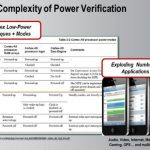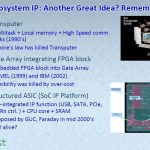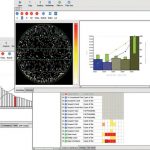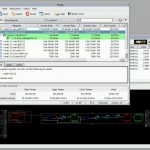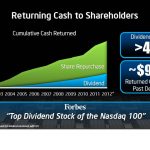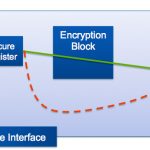Tim Cook’s strategy to disengage from Samsung as a supplier of LCDs, memory and processors while simultaneously creating a worldwide supply chain from the remnants of former leaders like Sharp, Elpida, Toshiba and soon Intel is remarkable in its scope and breadth. By 2014, Apple should have in place a supply chain for 500M iOS devices (iPhones, iPADs, iTVs and iPODs). Add in the near term foundry relationship with TSMC and it spells not just freedom but a true Vertical Operations independent from its number 1 competitor. Add to this the fact that Apple may soon be lower in cost, an inconceivable thought to most observers. How can Apple have lower cost than Samsung? This is the story of 2013-2014 as Tim Cook is attempting to put the last pieces in place to build affordable $200 iPhones and $250 iPAD Minis for the other half of the world that is currently unaddressed today (eg China Mobile and India).
A recent article in digitimes questions whether TSMC will have enough capacity to support Apple’s projected demand of 200MU while also servicing its other major customers like Qualcomm, Broadcom, nVidia and the rest of the leading edge silicon buyers. Will TSMC make the investment to capture all of mobile while Intel sits on three empty 14nm fabs? Not likely, unless Apple and Qualcomm write checks to guarantee the demand. Six months ago Qualcomm started down the path of diversification when demand skyrocketed and TSMC could not turn on a dime to fulfill. Tim Cook knows Jony Ive will continue to pump out great products at a more rapid pace in the coming quarters and try to deny Samsung and Microsoft an opening like in the past during summer lulls when yearly refreshes were still waiting in the wings. All that is holding Apple back is the global supply chain that is larger and lower cost than what Samsung has today.
Many in the press have spent the past 6 months talking about the transition taking place from Samsung to TSMC. They have overlooked how Apple is leveraging its Japan infrastructure to build LCDs, DRAM and NAND Flash at a time when the Yen is about to collapse. From the mid 1980s to today the Yen has appreciated by 300% relative to the dollar. Moore’s Law is a hugely deflationary force that requires a country to offset its Creative Destruction by inflating away its currency. So the US and half the world linked to the Dollar (including China) have prospered while the Japanese economy has contracted during these past 25 years. If the Yen drops dramatically from 80 to 120 or 150, as is necessary to restart their economy, then Apple will have the beginnings to its low cost strategy to outflank Samsung. A robust, high volume processor and baseband chip supply chain is all that remains.
When the Intel earnings call comes in January, I anticipate a number of analysts will demand a full accounting of the projected fab loadings for 22 and 14nm for 2013 and 2014. The timing of recent leaks on Intel and Apple negotiating a Fab deal is not unexpected. On the table are three 14nm Fabs that require no Apple capital investment to satisfy the demand beyond the 200MU that TSMC and Samsung can supply. Quite likely Apple has the opportunity to support more than 500MU additional units with Intel at current die sizes. But wait, Apple will get an extra shrink and significantly lower power in a move to Intel’s 14nm process. Therefore the Intel Fab option is really the one road available that catapult Apple beyond Samsung in their battle for market share leadership in Smartphones and Tablets. It is also the one option that is unavailable to Samsung.
Analyst Doug Freedman recently speculated that Intel and Apple are considering a Foundry partnership where the former agrees to build ARM chips for the iPhone while the latter will convert the iPAD to x86. It’s possible, but in the end I believe that three empty Fabs running 14nm Finfet is a much stronger religion than x86 architected chips. Intel would be happy with anything Apple wants built because there are tremendous sunk costs in place with the new fabs. This is where TSMC has to be cautious.
While Stacy Smith, Intel’s CFO, repeated at a conference last week that they don’t see PC volume falling again in 2013, there are hints that Ivy Bridge pricing has already been reduced to move the ultrabook price points down to sub $500. Smith also noted that 22nm Fab equipment is now being transitioned into 14nm fabs. The Ireland Fab may be on hold now, but in reality it is like an Aircraft Carrier waiting to be outfitted with Fighters. Six large Fabs are what await the combined x86 and Apple demand. Of the six, less than three are currently needed to support 350M PCs and 20M-x86 based Servers. Any slide in x86 demand just opens up more space for Apple and at lower prices.
At some point the operating margins building the A7 for Apple will cross above those of an Atom chip. Just to be clear, I am saying that an A7 will deliver more profit than an Atom chip when Sales, Marketing and Engineering costs are factored in for the latter. If Intel can sell Apple on its 4G LTE baseband, then the low cost, dual sourced processor and baseband supply chain will be complete.
Scenarios such as those above are only possible when markets are going through huge transitions. I am still intrigued by Intel’s decision to double its fab footprint back in 2010. What were the reasons for the boldness and is that view today still held internally. I can only speculate that they truly believed that they alone would get to 14nm while the rest of the industry faded.
Full Disclosure: I am Long AAPL, INTC, ALTR, QCOM



